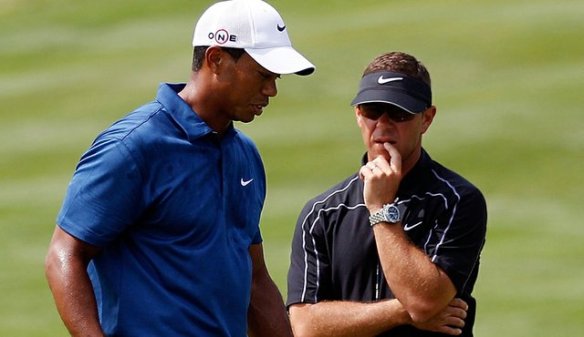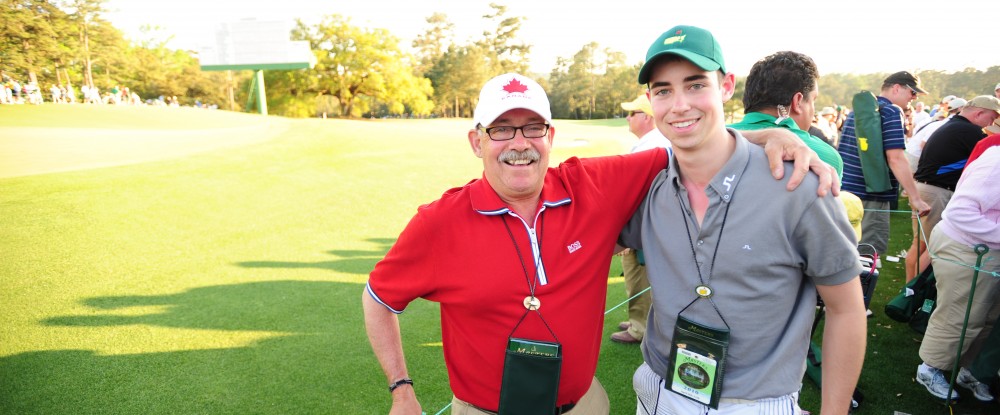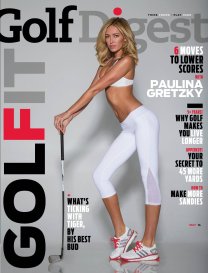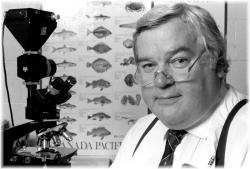By: Nick Murray – Thatsmyquarterback.com
May 18, 2014. Click here for original article
With Mike Weir and Graham DeLaet each going into today’s final round of the HP Byron Nelson Championship only one and two strokes off the lead, respectively, and with the potential to give Canada its first PGA tour win since Stephen Ames won the 2009 Children’s Miracle Network Classic, we thought we’d look at a few other Canadian connections on the PGA tour you may not know about.
1. Angie Watson

(Photo by Michael Cohen/Getty Images
Golf fans would recognize the six-foot-four Angie Watson from the two awesome embraces after her husband Bubba won the 2012 and 2014 Masters. But Canadian basketball fans may remember her as Angie Ball.
The Toronto native met Watson while the two attended Georgia University in the late 1990s and married in 2004. In her senior year she started 35 of the Lady Bulldogs’ 36 games and posted 7.2PPG while shooting 51 per cent from the field. Georgia advanced to the Elite Eight before losing 59-51 to Rutgers in the Regional Final.
She represented Canada at the 2000 Olympic Summer Games in Sydney where the team went 2-4 and finished 10th.
Ball went on to play in Italy for a while and then signed as a free agent with the WNBA’s Charlotte Sting before injuries forced her to retire.
I bumped into Ball at the Masters this year, literally.She’s still true to her Canadian roots though, apologizing to me even though I fouled her.
2. Sean Foley

(Image via Golfweek)
Sean Foley may be one of the best and arguably most intelligent coaches on the PGA tour.
The Burlington, Ont., native has worked on the swings of some of the game’s best players including Justin Rose, Hunter Mahan, Sean O’Hair, Stephen Ames, and formerly Lee Westwood before the two parted ways earlier this year.
Arguably most notable on Team Foley is Tiger Woods, who jumped on board in 2010.
Foley golfed at Tennessee State and graduated with a B.A. in 1998, but don’t let the Arts degree fool you, he’s incredibly intelligent. His deep philosophical mindset was on full display in a 2010 Golf Digest article by Jamie Diaz.
“He said learning to deal with being a minority on a campus that was predominantly black was a challenge that became one of the most important experiences of his life,” Diaz wrote on Foley’s time at Tennessee State.
And on his appreciation for Tiger, Diaz quoted Foley saying: “I’ve always appreciated what he is doing in a historically Caucasian sport. And I think because of my experiences I have empathy for that cause and for him.”
3. Wayne Gretzky

(Image via SFGate.com)
I really didn’t want to go here, but the Great One is soon to become the father-in-law of PGA long-bomber Dustin Johnson.
While Paulina Gretzky isn’t Canadian-born, she and Johnson got engaged back in August. But the NHL heiress isn’t being warmly welcomed in all of golf’s circles. We’ve all seen the May 2014 cover of Golf Digest, featuring Gretzky in white yoga pants and a matching sports bra, and seven-time LPGA major-winner Julie Inkster was less than impressed.
Even the New York Times jumped on the controversy in April, reporting that Gretzky was only one of 11 women since 1969 to ever grace the cover with a solo shot. Only one other woman of that 11 has never won a pro event or amateur major: The Golf Channel’s Holly Saunders.
“It’s frustrating because it’s Golf Digest; it’s not Sports Illustrated’s swimsuit issue. I think they should maybe recognize some of the great women golfers that we have. It’s like, What do you have to do to get a little respect? I’m guaranteeing you right now, it was not a woman editor who chose that cover,” said Inkster in the April New York Times article by Karen Crouse.
4. PGA Tour Canada

(Image via PGA)
Many golf fans overlook this but the PGA actually has a Canadian tour – much like the PGA Tour China it’s a springboard for many player to earn their Web.com Tour cards. For baseball fans, PGA Tour Canada is basically double-A and the Web.com tour is triple-A.
It doesn’t foster the same tournament purses as The Show, if you will, but last year Dundas, Ont., native Mackenzie Hughes bankrolled $52,114 through nine events. The top five money earners each year earn Web.com tour cards.
The Tour itself started back in 1970 but was taken over by the PGA in 2012 and rebranded as PGA Tour Canada, and is operating much smoother under the PGA brand.
Mike Weir got his start on the tour in 1993 – formerly the Canadian Professional Golf Tour – winning Rookie of the Year honours, before qualifying for the PGA tour in 1998.
Other PGA notables who’ve passed through the Canadian Tour ranks include former British Open winner Todd Hamilton, Stuart Appleby, Chris DiMarco, Stephen Ames and 2005 U.S. Open champ Michael Campbell.
Full disclosure that TMQ is not sponsored by RBC – though not closed to the idea – but it’s hard to ignore Canada’s largest financial institution on the PGA Tour.
Aside from being the title sponsor for the Canadian Open since 2008, and the Heritage since 2012, RBC has ensured its gold lion is spotted at almost every possible opportunity. Members of Team RBC include Canadians Weir, Ames, David Hearn and DeLaet – I should think so – as well as big names like Ernie Els, Hunter Mahan, Matt Kuchar, Jim Furyk, Luke Donald and Brandt Snedeker, among others.
Funny thing is RBC sold off its retail branches in the United States to PNC Financial (think Pittsburgh Pirates) in 2011. The peppering of ads must be for those secret Cayman Island account holders…



 Wed Apr 16 2014
Wed Apr 16 2014





